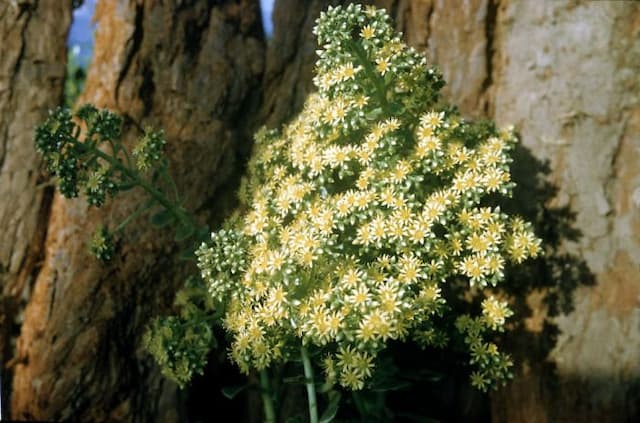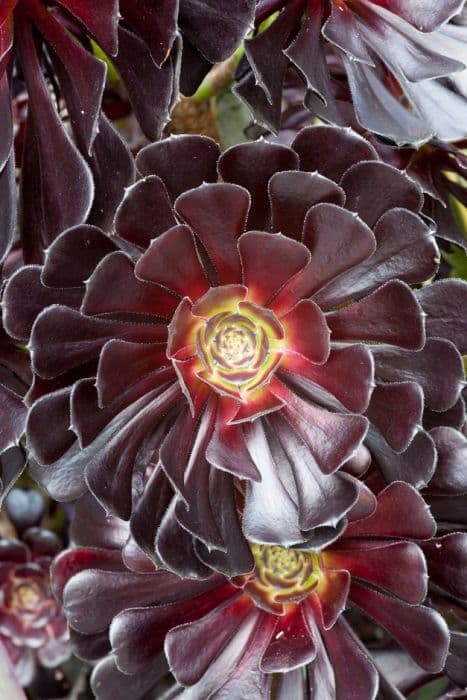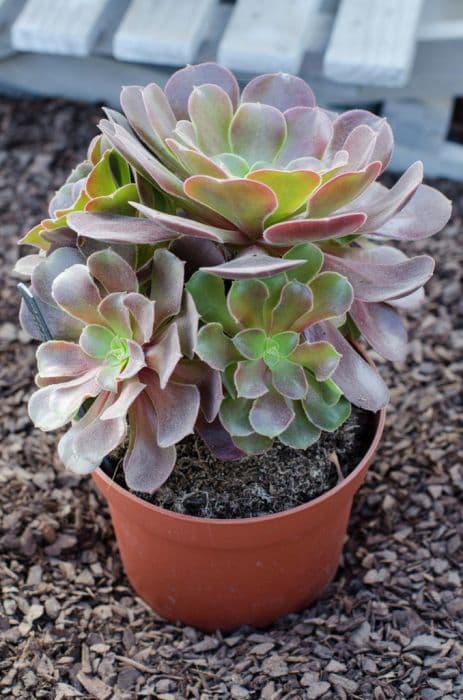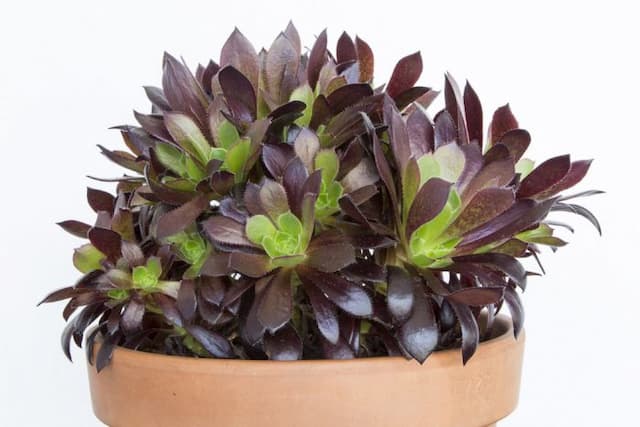Autumn Joy Hylotelephium (Herbstfreude Group) 'Herbstfreude'

ABOUT
The plant known commonly as 'Autumn Joy' sedum features fleshy, succulent leaves that are arranged in whorls along its stems. The leaves are a glaucous, light bluish-green or grayish-green color, giving them a somewhat waxy texture. As the plant matures, it forms sturdy, upright clumps that efficiently hold the weight of its flowers. The flowers of 'Autumn Joy' sedum are one of its most striking features. They appear in dense clusters at the ends of the stems and emerge a light pink hue, deepening to a rich coppery-pink as they age throughout the late summer and into the fall. These flower heads are broad, flat and can add a touch of intense color to the garden during a season when many plants are starting to fade. The overall shape of 'Autumn Joy' sedum is generally very rounded and it has a clumping habit, giving it a substantial presence in the landscape. The leaves and flowers together create an appealing contrast in textures, with the smooth leaves setting off the more intricate, star-shaped flowers. After the blooming period, the seed heads of the flowers remain on the plant through the winter, providing an additional visual interest and essential food source for birds.
About this plant
 Names
NamesFamily
Crassulaceae
Synonyms
Autumn Joy, Stonecrop, Herbstfreude Sedum
Common names
Sedum spectabile 'Herbstfreude', Sedum 'Herbstfreude', Hylotelephium spectabile 'Herbstfreude'.
 Toxicity
ToxicityTo humans
Autumn Joy (Hylotelephium 'Herbstfreude') is not considered highly toxic to humans. However, if any part of the plant is ingested in large amounts, it could potentially cause mild stomach upset, nausea, vomiting, or diarrhea. Contact with the sap may cause skin irritation in sensitive individuals.
To pets
Autumn Joy (Hylotelephium 'Herbstfreude') is generally considered non-toxic to pets such as dogs and cats. While ingestion might lead to minor gastrointestinal upset like vomiting or diarrhea if consumed in large amounts, it is not known for causing severe poisoning or life-threatening symptoms in pets. However, it is always prudent to prevent pets from eating plants as individual reactions can vary.
 Characteristics
CharacteristicsLife cycle
Perennials
Foliage type
Deciduous
Color of leaves
Green
Flower color
Pink
Height
1-2 feet (30-60 cm)
Spread
1-2 feet (30-60 cm)
Plant type
Herb
Hardiness zones
3-9
Native area
Asia Europe
Benefits
 General Benefits
General Benefits- Easy to Grow - Hylotelephium 'Herbstfreude', commonly known as Sedum 'Autumn Joy', is a low-maintenance plant that thrives in a variety of conditions and is suitable for gardeners of all skill levels.
- Drought Tolerant - With succulent leaves that store water, Sedum 'Autumn Joy' is highly drought-resistant, which makes it an ideal choice for xeriscaping and water-wise gardens.
- Attracts Pollinators - The flowers of Sedum 'Autumn Joy' are attractive to butterflies, bees, and other pollinators, helping to support local ecosystems.
- Seasonal Interest - This plant features a long blooming season from late summer into fall, providing a long-lasting display of color in the garden when many other plants have finished flowering.
- Winter Interest - After the blooming period, Sedum 'Autumn Joy' can leave a structural interest in the garden with its seed heads during the winter months.
- Versatile Landscaping - Due to its clumping habit and attractive appearance, it can be used in rock gardens, borders, and as a ground cover.
- Edible Qualities - Some parts of the plant are edible and can be used in salads or as a garnish, though they are not commonly consumed.
- Low Pest and Disease Issues - Sedum 'Autumn Joy' is not prone to many pests or diseases, reducing the need for chemical treatments.
 Medical Properties
Medical PropertiesThis plant is not used for medical purposes.
 Air-purifying Qualities
Air-purifying QualitiesThis plant is not specifically known for air purifying qualities.
 Other Uses
Other Uses- Sedum 'Herbstfreude', also known as Autumn Joy, can be used in green roofing projects due to its drought tolerance and hardy nature, helping to insulate buildings and manage storm water.
- The plant's sturdy stems can be utilized in flower arranging and provide support for other, more delicate flowers in a bouquet or arrangement.
- Autumn Joy is often used as a border plant to create texture and interest in garden design due to its striking foliage and vibrant autumn flower color.
- Its late blooming period makes it an important food source for pollinators, like bees and butterflies, when other flowers have finished blooming.
- Dried flower heads can be sprayed with metallic paint and used as festive decorations during the holiday season.
- Plant enthusiasts can use the succulent leaves in miniature gardens or fairy gardens as a low-maintenance plant that resembles small-scale shrubbery or trees.
- The diverse range of colors throughout the seasons, from green to pink to russet, can be used by artists and designers for color palette inspiration.
- Gardeners can propagate Sedum 'Herbstfreude' using leaf cuttings to grow new plants, which can be a fun and educational project for children and adults alike.
- Creative pet owners have used trimmed, non-toxic foliage as a resilient, decorative bedding in enclosures for small pets like tortoises.
- The plant can act as a ground cover, suppressing weeds and minimizing garden maintenance in large plantings or public green spaces.
Interesting Facts
 Feng Shui
Feng ShuiThe plant Sedum 'Autumn Joy' is not used in Feng Shui practice.
 Zodiac Sign Compitability
Zodiac Sign CompitabilityThe plant Sedum 'Autumn Joy' is not used in astrology practice.
 Plant Symbolism
Plant Symbolism- Enduring Love: The Autumn Joy, as it blooms from late summer to fall, symbolizes love that endures through time and season.
- Resilience: Known for its ability to thrive in tough conditions, it represents resilience and the ability to withstand challenges.
- New Beginnings: As a perennial that returns each year, the Autumn Joy signifies renewal and the start of a new cycle.
- Prosperity: The full, abundant heads of the plant suggest a sense of wealth and prosperity.
- Longevity: The plant's long life and late blooming period symbolize longevity and late-life vitality.
 Water
WaterThe Autumn Joy Sedum, known botanically as Hylotelephium 'Herbstfreude', prefers to be watered deeply but infrequently to mimic natural conditions. It is drought-tolerant, so you should allow the top inch of the soil to dry out before watering again. Typically, this means watering every 7 to 10 days during the active growing season, depending on climate and weather conditions. When you do water, avoid overhead watering to prevent fungal diseases and instead water at the base of the plant. An approximate guideline would be to use about 0.5 gallons of water for an average-sized plant each time you water.
 Light
LightAutumn Joy Sedum thrives in full sun to partial shade. It is best to position the plant in a spot where it can receive at least 6 hours of direct sunlight per day. Dappled sunlight the rest of the day is fine, but too much shade can lead to leggy growth and weaker stems.
 Temperature
TemperatureThe Autumn Joy Sedum is hardy and can withstand a wide range of temperatures, typically from as low as -30°F to as high as 90°F, but it thrives best in temperate conditions. The ideal growing temperatures for this plant are between 65°F and 75°F during its active growing season.
 Pruning
PruningPruning the Autumn Joy Sedum helps to maintain its shape and encourage a more robust and floriferous plant. It is best to prune in the early spring, cutting back the old growth before new buds appear. Some gardeners also practice a late spring or early summer 'pinching' to promote bushier growth. Pruning can be done annually or as needed to remove dead stems and spent flowers.
 Cleaning
CleaningAs needed
 Soil
SoilAutumn Joy Sedum prefers a well-draining soil mix with coarse sand or perlite mixed into a standard potting soil. The ideal soil pH for this plant is slightly acidic to neutral, ranging from 6.0 to 7.5. Providing good drainage is crucial to prevent root rot and ensure the health of the plant.
 Repotting
RepottingAutumn Joy Sedum doesn't need frequent repotting and can thrive in the same pot for several years. Typically, repotting every 3 to 5 years is adequate to refresh the soil and provide room for growth.
 Humidity & Misting
Humidity & MistingAutumn Joy Sedum is tolerant of a wide range of humidity levels and does not require high humidity to thrive. It is well-suited to the average humidity levels found in most homes or outdoor environments.
 Suitable locations
Suitable locationsIndoor
Provide bright light and well-drained soil.
Outdoor
Plant in full sun and well-drained soil.
Hardiness zone
3-9 USDA
 Life cycle
Life cycle'Herbstfreude', also known as Autumn Joy stonecrop, starts its life as a seed that germinates in spring under the right conditions of warmth and moisture. The seedling develops into a rosette of succulent leaves at the soil surface, which then grows and produces a sturdy, upright stem. During summer, the plant continues to grow and store energy in its fleshy leaves, and by late summer or early fall, it begins to form clusters of buds at the top of each stem. These buds bloom into star-shaped flowers, usually in shades of pink, which gradually deepen to a coppery red as cooler weather arrives in the fall. After flowering, the plant goes dormant for the winter, with the dead stems and flower heads often left standing to provide winter interest and habitat for wildlife. In the spring, new growth emerges from the base of the plant, and the cycle begins anew.
 Propogation
PropogationPropogation time
Spring-Early Summer
The most popular method to propagate Hylotelephium 'Herbstfreude', commonly known as Autumn Joy, is by division. This is typically done in early spring as new growth begins to emerge. You should dig up the entire clump of Autumn Joy and gently separate it into smaller sections, ensuring each new piece has a segment of the root system attached. These sections can then be immediately replanted in a well-draining soil mix at a similar depth to which they were originally growing. Water the newly planted divisions regularly until they are established and showing signs of new growth. This method is quick, simple, and effective for increasing your stock of Autumn Joy sedum.









